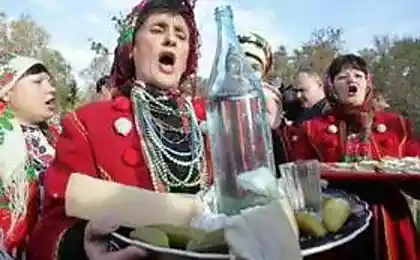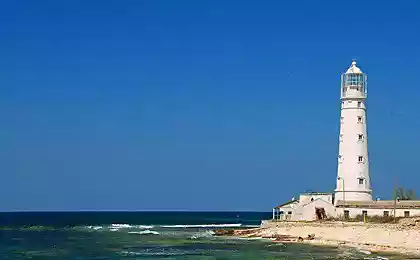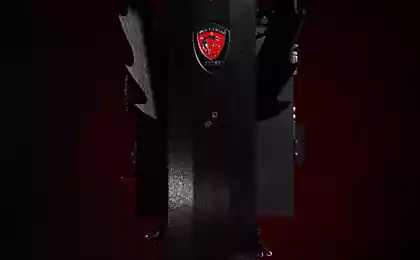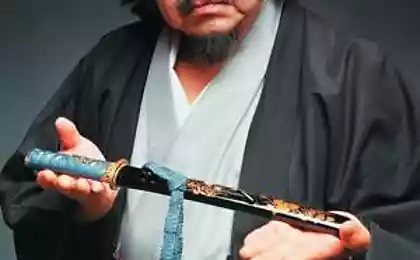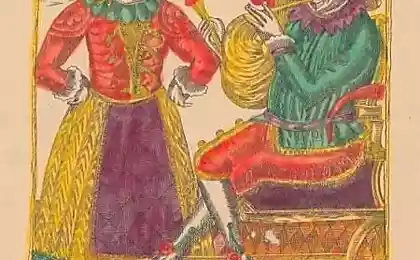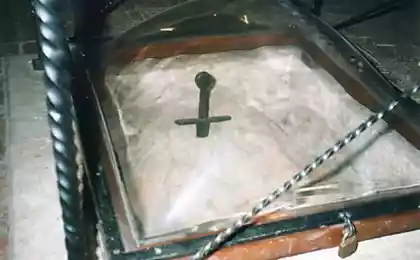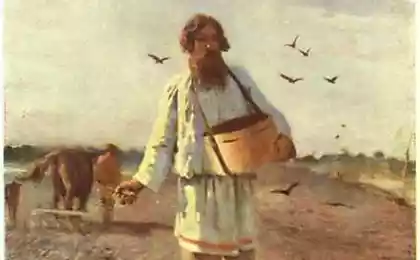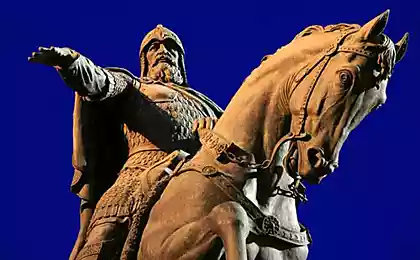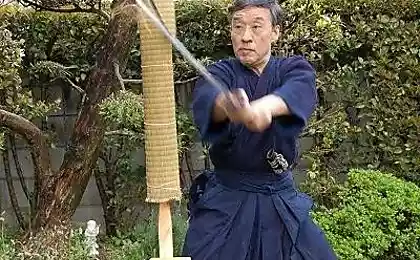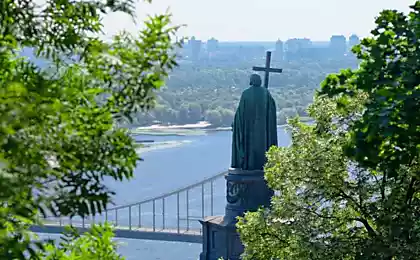1034
About the cult of the sword in ancient Russia
15 Photos
About the cult of the sword in ancient Russia knows quite a bit, it was not as pronounced as, for example, in medieval Japan. But, nevertheless, there he is with us, not without reason in Russian epics acquisition or possession of the sword furnishes with special reverence. There were concepts like sword kladenets, swordfish or samosek samorub, also known as "sword-hundred head-shoulders" giant sword and so forth.
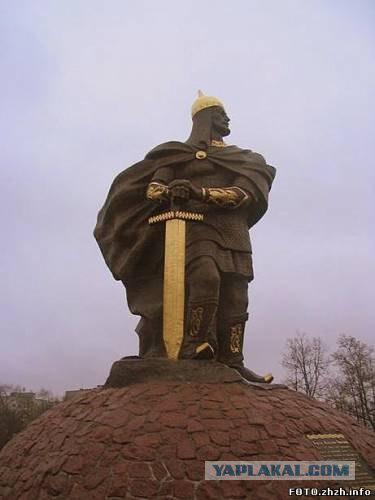
2
The Old Sword differed little from the swords of Western Europe, we can say no different. Dimensions and weight were similar. About 100 cm. Long and 1 kg. weight. Of course there were swords and giant size, but this is rare.
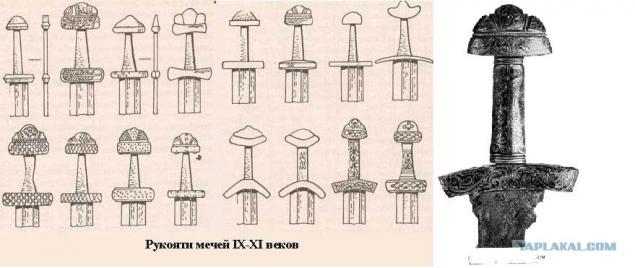
3
It is often argued that the first Russian swords were blunt and did not have the edge, I think, these statements do not deserve attention. Thrusting known since time immemorial, fencing technique is unthinkable without such a blow. The same leather cuirass easier to pierce than cut if it were otherwise - neither the Greeks nor the Romans had swords with a sharpened tip. Some "experts" say that the Roman Gladius had sharpened tip - this is nonsense.
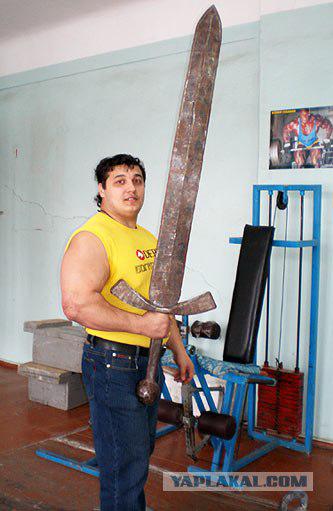
4
"The most appropriate Romans believed thrust because it required much less time and space than chopping. Thrust was much easier to break through "soft" armor, and even armor. " This is confirmed by Tacitus, describing the war with the Romans Sarmatians. The Icelandic sagas soldiers committed suicide by throwing himself on the sword - "He stuck his sword hilt in the ice and fell on the edge." Link to the extant chronicles, in which there appears piercing kick from the XIII century, does not prove anything chronicle is all the same not a textbook on fencing. Such nuances ancient chroniclers of little interest, the main task of these documents is a reflection of the socio-political events.
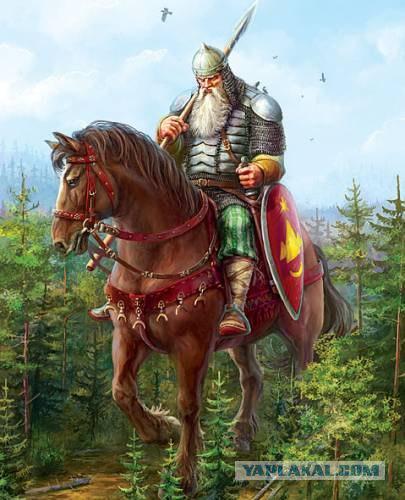
5
Swords, who controlled the ancient Russians can be divided into iron, steel and damask. The swords of Damascus steel is also divided into two groups: Bulat Bulat casting and welding. The word "damask" probably comes from the field in Persia - Puluadi, which was famous for trade knives. Although the best damask forged in India, and only later in Persia, 'Damascus' (the name of the place of trade, the true casting Bulat was an Indian) molding or cast Bulat, which is famous for its flexibility, is not well suited for the ancient warriors. He did not tolerate low temperatures, humidity, etc. Climatic factors, therefore increasing distribution was welded Bulat. Blades are forged from which Russian masters.
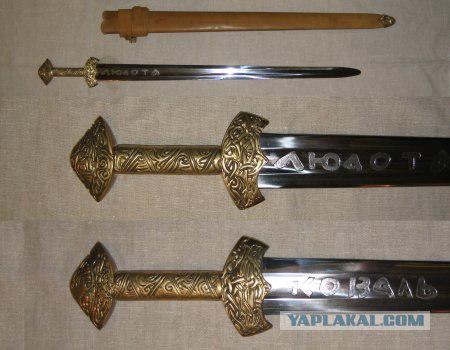
6
Doctor of Technical Sciences Yu Gurevich in his remarkable work "The Mystery damask pattern" made a definite conclusion: in Russia for centuries knew how to make the welded Damascus steel. These swords were appreciated both in Europe and in the East. Although they did not have the flexibility of the legendary "Damascus", but there were also sharp and durable.
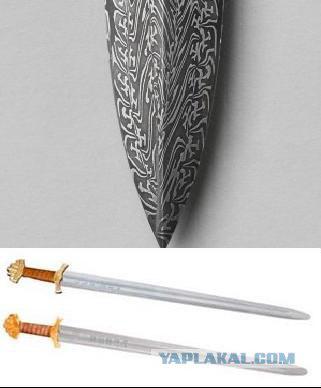
7
The most famous of the first blacksmiths became Lyudota, the master of the IX century hammered Damascus steel swords. Apparently, this was one of the first productions of weapons of ancient Russia. A profession blacksmiths mechedeltsev considered one of the most honorable and yet was surrounded by a mystical aura. After smiths of old were considered descendants of Svarog bearers of the sacred knowledge. Favorites Only the best Mogi forge swords, Damascus steel is very capricious, no sword is not like another. Before you begin to forge a new sword smith sacrificed Svarog, priests and consecrated this sacrament and, only then, you can get to work.
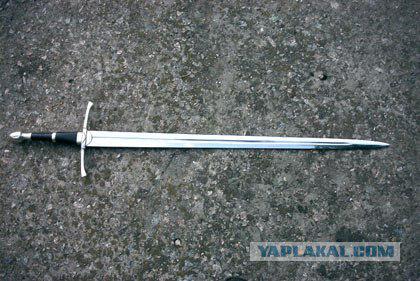
8
Swords Cowan to order the owner of a particular bore the distinctive features. Not only in size and weight, but also in the finishing of the handle. Doly, which are sometimes called "krovospuskom", intended not so much to facilitate weapons as to impart rigidity, and some define them as reinforcement ribs. Sword dismissed the color or in precious metals, as well as enamel or black. We cover the patterns of mythological scenes, whose names were given swords or ancient gods, or totem animals: Ruyev, Lamya, Indrikis, Kitovras, Basilisk, etc. Gorynya.
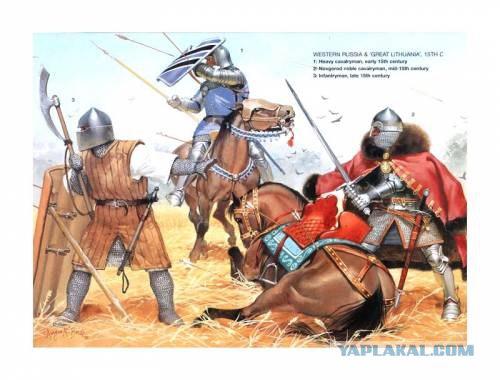
9
Apart here are magic swords, by means of which certain religious rites. "Sword sacral as such is confirmed as the epic, and legal sources." These swords were covered with runic spells and used as instruments of magic attack and defense. Also, there was a custom of the Slavs - newborn baby laying in front of a naked sword, as if indicating that he should get a sword fame and wealth.

10
The great warrior had a famous sword, one mention of the name which resulted in awe enemies. Recalling the ancient heroes or historical figures - the apotheosis ratoborstva always been a duel with swords. Net ringing damask blade is itself destroyed the negative energy of the enemy, and the experienced hand of its owner completes battle accurate smashing blow. When the owner died damask sword or die - a sword, too, deprived of "life," it broke and buried in the same grave. Mother-Raw-Earth was taking the magical power of the sword, so the sword of the barrows never brings good luck to the new owner.
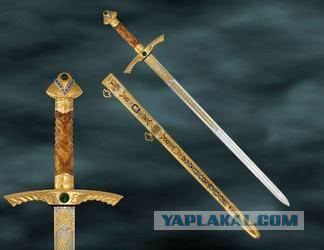
11
The cult of the sword is preserved even when the widely received firearms. Recall the fact that there were signs of Valor, which were worn exclusively on cold steel. Sacred meaning of the sword once again revived in the famous Sword of the Victory of the Great Patriotic War. No wonder, a Russian soldier-liberator forever stood with a sword in the hands of the German Treptow Park and froze Motherland with sword on the Mamaev Hill.
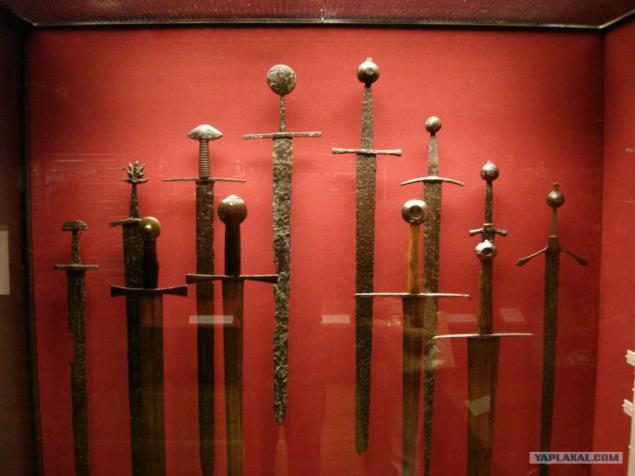
12
Sword - in Russia since ancient times was the preferred weapon and wore it as a rule, had a high public profile. Sword consisted of broad, sharp on both sides of the strip, that is, the blade and the handle of Kryzhi, parts of which were called: apple, is black and steel. Each flat side of the blade called "golomen" or "naked", and the island - "blades." On golomenyah made one wide or several narrow grooves. The blades are made of steel or iron sword sheathed, upholstered in leather or later velvet. Sheath made of iron and sometimes decorated with gold or silver notches. Sword append to the belt by two rings located at the mouth of the scabbard.
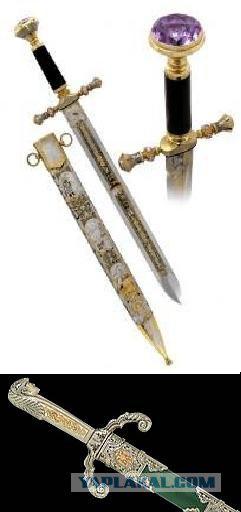
13
Sword - the main weapon of the Russian warrior-combatant, a symbol of royal authority and the military emblem of ancient Russia. Russian chronicles and other written sources are full of references to the sword. No less well represented swords and archaeological material. The bulk of the sword, as well as other weapons, came to us from the X century. Burials warrior princes - Igor, Svyatoslav and Vladimir Svyatoslav includes a rich set of weapons and other military equipment.
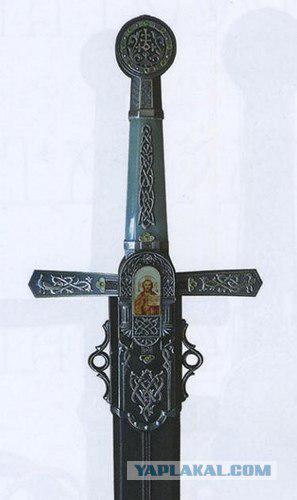
14
The Old sword - slashing weapons, "lest uschityatsya shields and their swords will be let posechennymi his" or "posekosha sword mercilessly." But some expressions chronicles, however, later, suggest that the sword was used sometimes for slaughtering the enemy, "the little window to prizvavshe pronzut and sword." The usual length of the sword of X century was about 80 - 90 cm. The width of the blade was 5 - 6 cm, thickness 4 mm. Along the fabric on both sides of the blade of the swords are ancient valleys, which served to reduce the weight of the blade. The end of the sword is not intended to thrust, I had a rather blunt tip, and sometimes even just round off. The pommel, hilt and crossed swords almost always decorated with bronze, silver and even gold. In the annals of common expression "Draw your sword."
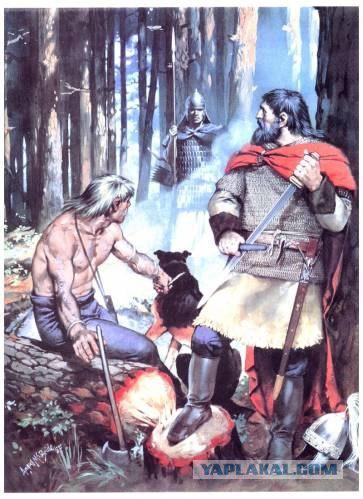
15
So, we see that the ancient smiths hammered for his fellow soldiers swords, possessed sophisticated technology blacksmith forging patterned welding and heat treatment and production techniques and artistic finish not inferior to western or eastern masters. In the art of finishing the blades of swords they even outnumbered the famous Oriental gunsmiths, make swords of Damascus steel!

Source:
About the cult of the sword in ancient Russia knows quite a bit, it was not as pronounced as, for example, in medieval Japan. But, nevertheless, there he is with us, not without reason in Russian epics acquisition or possession of the sword furnishes with special reverence. There were concepts like sword kladenets, swordfish or samosek samorub, also known as "sword-hundred head-shoulders" giant sword and so forth.

2
The Old Sword differed little from the swords of Western Europe, we can say no different. Dimensions and weight were similar. About 100 cm. Long and 1 kg. weight. Of course there were swords and giant size, but this is rare.

3
It is often argued that the first Russian swords were blunt and did not have the edge, I think, these statements do not deserve attention. Thrusting known since time immemorial, fencing technique is unthinkable without such a blow. The same leather cuirass easier to pierce than cut if it were otherwise - neither the Greeks nor the Romans had swords with a sharpened tip. Some "experts" say that the Roman Gladius had sharpened tip - this is nonsense.

4
"The most appropriate Romans believed thrust because it required much less time and space than chopping. Thrust was much easier to break through "soft" armor, and even armor. " This is confirmed by Tacitus, describing the war with the Romans Sarmatians. The Icelandic sagas soldiers committed suicide by throwing himself on the sword - "He stuck his sword hilt in the ice and fell on the edge." Link to the extant chronicles, in which there appears piercing kick from the XIII century, does not prove anything chronicle is all the same not a textbook on fencing. Such nuances ancient chroniclers of little interest, the main task of these documents is a reflection of the socio-political events.

5
Swords, who controlled the ancient Russians can be divided into iron, steel and damask. The swords of Damascus steel is also divided into two groups: Bulat Bulat casting and welding. The word "damask" probably comes from the field in Persia - Puluadi, which was famous for trade knives. Although the best damask forged in India, and only later in Persia, 'Damascus' (the name of the place of trade, the true casting Bulat was an Indian) molding or cast Bulat, which is famous for its flexibility, is not well suited for the ancient warriors. He did not tolerate low temperatures, humidity, etc. Climatic factors, therefore increasing distribution was welded Bulat. Blades are forged from which Russian masters.

6
Doctor of Technical Sciences Yu Gurevich in his remarkable work "The Mystery damask pattern" made a definite conclusion: in Russia for centuries knew how to make the welded Damascus steel. These swords were appreciated both in Europe and in the East. Although they did not have the flexibility of the legendary "Damascus", but there were also sharp and durable.

7
The most famous of the first blacksmiths became Lyudota, the master of the IX century hammered Damascus steel swords. Apparently, this was one of the first productions of weapons of ancient Russia. A profession blacksmiths mechedeltsev considered one of the most honorable and yet was surrounded by a mystical aura. After smiths of old were considered descendants of Svarog bearers of the sacred knowledge. Favorites Only the best Mogi forge swords, Damascus steel is very capricious, no sword is not like another. Before you begin to forge a new sword smith sacrificed Svarog, priests and consecrated this sacrament and, only then, you can get to work.

8
Swords Cowan to order the owner of a particular bore the distinctive features. Not only in size and weight, but also in the finishing of the handle. Doly, which are sometimes called "krovospuskom", intended not so much to facilitate weapons as to impart rigidity, and some define them as reinforcement ribs. Sword dismissed the color or in precious metals, as well as enamel or black. We cover the patterns of mythological scenes, whose names were given swords or ancient gods, or totem animals: Ruyev, Lamya, Indrikis, Kitovras, Basilisk, etc. Gorynya.

9
Apart here are magic swords, by means of which certain religious rites. "Sword sacral as such is confirmed as the epic, and legal sources." These swords were covered with runic spells and used as instruments of magic attack and defense. Also, there was a custom of the Slavs - newborn baby laying in front of a naked sword, as if indicating that he should get a sword fame and wealth.

10
The great warrior had a famous sword, one mention of the name which resulted in awe enemies. Recalling the ancient heroes or historical figures - the apotheosis ratoborstva always been a duel with swords. Net ringing damask blade is itself destroyed the negative energy of the enemy, and the experienced hand of its owner completes battle accurate smashing blow. When the owner died damask sword or die - a sword, too, deprived of "life," it broke and buried in the same grave. Mother-Raw-Earth was taking the magical power of the sword, so the sword of the barrows never brings good luck to the new owner.

11
The cult of the sword is preserved even when the widely received firearms. Recall the fact that there were signs of Valor, which were worn exclusively on cold steel. Sacred meaning of the sword once again revived in the famous Sword of the Victory of the Great Patriotic War. No wonder, a Russian soldier-liberator forever stood with a sword in the hands of the German Treptow Park and froze Motherland with sword on the Mamaev Hill.

12
Sword - in Russia since ancient times was the preferred weapon and wore it as a rule, had a high public profile. Sword consisted of broad, sharp on both sides of the strip, that is, the blade and the handle of Kryzhi, parts of which were called: apple, is black and steel. Each flat side of the blade called "golomen" or "naked", and the island - "blades." On golomenyah made one wide or several narrow grooves. The blades are made of steel or iron sword sheathed, upholstered in leather or later velvet. Sheath made of iron and sometimes decorated with gold or silver notches. Sword append to the belt by two rings located at the mouth of the scabbard.

13
Sword - the main weapon of the Russian warrior-combatant, a symbol of royal authority and the military emblem of ancient Russia. Russian chronicles and other written sources are full of references to the sword. No less well represented swords and archaeological material. The bulk of the sword, as well as other weapons, came to us from the X century. Burials warrior princes - Igor, Svyatoslav and Vladimir Svyatoslav includes a rich set of weapons and other military equipment.

14
The Old sword - slashing weapons, "lest uschityatsya shields and their swords will be let posechennymi his" or "posekosha sword mercilessly." But some expressions chronicles, however, later, suggest that the sword was used sometimes for slaughtering the enemy, "the little window to prizvavshe pronzut and sword." The usual length of the sword of X century was about 80 - 90 cm. The width of the blade was 5 - 6 cm, thickness 4 mm. Along the fabric on both sides of the blade of the swords are ancient valleys, which served to reduce the weight of the blade. The end of the sword is not intended to thrust, I had a rather blunt tip, and sometimes even just round off. The pommel, hilt and crossed swords almost always decorated with bronze, silver and even gold. In the annals of common expression "Draw your sword."

15
So, we see that the ancient smiths hammered for his fellow soldiers swords, possessed sophisticated technology blacksmith forging patterned welding and heat treatment and production techniques and artistic finish not inferior to western or eastern masters. In the art of finishing the blades of swords they even outnumbered the famous Oriental gunsmiths, make swords of Damascus steel!

Source:
